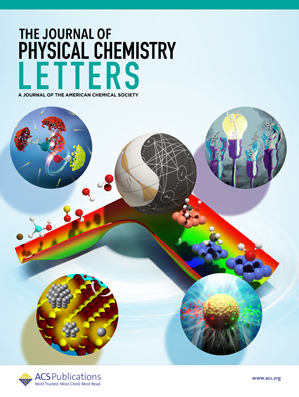大环手性分子的光学特性:环尺寸增加的限制
IF 4.8
2区 化学
Q2 CHEMISTRY, PHYSICAL
引用次数: 0
摘要
手性大环分子作为开发具有大不对称因子(g)的圆偏振发光(CPL)有机发光体的潜在候选分子,受到了广泛的研究。在此,我们基于随时间变化的密度泛函理论计算,研究了大环尺寸与手性之间的关系。我们的研究结果表明,过渡到第一激发态(S0 → S1)的旋转强度(R)随大循环环面积的增加而线性增加。虽然这种演化可能会在超大环的情况下促进高 g 值,但我们发现,系统尺寸的增加会导致几个低洼转变的能量准退化。在大型大环中,在这些转变中,振荡强度大但 g 值小的高能转变比 S0 → S1 转变占主导地位。而且,这些最低激发态之间能量间隔的相应减小会通过伪雅恩-泰勒效应引发 S1 态几何对称性的破坏。总之,我们的研究结果突出表明,在大型大循环中,CPL 的强度可以增加,但这是以牺牲 g 值为代价的。因此,在设计大尺寸 CPL 发射器时,必须仔细考虑 S0 → S1 转变与高能态的相互作用。本文章由计算机程序翻译,如有差异,请以英文原文为准。

Optical Properties of Macrocyclic Chiral Molecules: The Limitations of Ring Size Increase
Chiral macrocyclic molecules are extensively investigated as potential candidates to develop organic emitters exhibiting circularly polarized luminescence (CPL) with large dissymmetry factors (g). Here, based on time-dependent density functional theory calculations, we investigate the relationship between macrocycle size and chiral properties. Our results underline that the rotatory strength (R) of the transition to the first excited state (S0 → S1) increases linearly with the macrocycle loop area. While this evolution could promote high g values in the case of very large rings, it is found that the increase in system size can lead to energetic quasi-degeneracy of several low-lying transitions. In large macrocycles, among those transitions, it is the slightly higher-energy transitions possessing large oscillator strengths but small g values that come to dominate over the S0 → S1 transition. Also, the corresponding decrease in energy spacing among these lowest excited states can trigger a broken symmetry of the S1-state geometry via a pseudo Jahn–Teller effect. Overall, our results highlight that in large macrocycles the CPL can gain in intensity but this occurs at the expense of the g value. Thus, it is critical that the interaction of the S0 → S1 transition with higher-energy states be carefully considered when designing large-size CPL emitters.
求助全文
通过发布文献求助,成功后即可免费获取论文全文。
去求助
来源期刊

The Journal of Physical Chemistry Letters
CHEMISTRY, PHYSICAL-NANOSCIENCE & NANOTECHNOLOGY
CiteScore
9.60
自引率
7.00%
发文量
1519
审稿时长
1.6 months
期刊介绍:
The Journal of Physical Chemistry (JPC) Letters is devoted to reporting new and original experimental and theoretical basic research of interest to physical chemists, biophysical chemists, chemical physicists, physicists, material scientists, and engineers. An important criterion for acceptance is that the paper reports a significant scientific advance and/or physical insight such that rapid publication is essential. Two issues of JPC Letters are published each month.
 求助内容:
求助内容: 应助结果提醒方式:
应助结果提醒方式:


